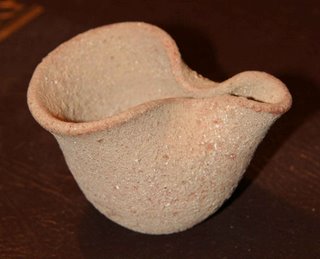This most fundamental of household accessories was as ubiquitous in antiquity as lightbulbs are today. Thus, these terra cotta lamps are among the most frequently excavated artifacts at dig sites from the Iron Age to the Islamic period, spanning the Middle East and throughout the ancient world.
The utility of these lamps is obvious. After all, how much more basic can it be than to dispel the darkness and tame the night?
But these lamps also have a very strong spiritual connection: The introduction of light is a metaphor for the dispelling of ignorance.
The Gospel of Luke advises: "Do not hide your lamp under a bushel, put it on a lampstand in the room so that all may see."
The Buddha's final words were said to have been "Be a light unto yourselves."
Here are a couple of lamps from my small collection.


 Roman oil lamp from the 1st or 2nd century. This lamp was made from a mold. On the discus -- the round, recessed cirular part of the top of the lamp -- there is a scene of a donkey jumping over a sleeping dog. Unfortunately, it's almost impossible to make out in these shots. This type of lamp is commonly found at Roman sites throughout Italy and in every part of the former Roman Empire.
Roman oil lamp from the 1st or 2nd century. This lamp was made from a mold. On the discus -- the round, recessed cirular part of the top of the lamp -- there is a scene of a donkey jumping over a sleeping dog. Unfortunately, it's almost impossible to make out in these shots. This type of lamp is commonly found at Roman sites throughout Italy and in every part of the former Roman Empire. Israelite lamp, circa 300 B.C.E. This lamp was thrown on a potter's wheel. It's about the size of an espesso cup.
Israelite lamp, circa 300 B.C.E. This lamp was thrown on a potter's wheel. It's about the size of an espesso cup. Mold-made lamp from the Byzantine era, around 400-500. This lamp features such Jewish iconography as a menorah (near the spout) and stylized bunches of grapes.
Mold-made lamp from the Byzantine era, around 400-500. This lamp features such Jewish iconography as a menorah (near the spout) and stylized bunches of grapes.
5 comments:
Wow - nice antiquities. Light was an important invention - it allowed mankind to live and work according to his own schedule, and not be limited simply by the presence or absence of the sun. Electric light in particular made a profound impact on our lives - and our night lives!
That is so interesting, the study of these lamps, and how someone researched and found the details actually could be deciphered. I wonder if someday someone will find our artifacts from today and see a lack of that, or see it as just prefabricated-cookie cutter stuff. (Did that make sense?)
Its amazing how something so little can mean so much.
Hi Matt,
Very true!
Hi LB,
Arcaheologists have always been interested in the trash of civilizations. Garbage heaps tell much about the civilization that created them. If humanity survives that long, I'm sure our garbage will be just as fascinating to those studying it two millenia from now.
It's just kind of difficult for me to think of some future collector marveling over a battered, discarded flashlight, or the rusted remains of the battery that powered it.
Michael- You can make a great article out of the most simplistic of subjects. Great post!
I recently got a stringer job at my local newspaper. My first article was published over the weekend.
Thanks for all the information and encouragment you given me with my interests in writing and journalism.
Hi Lone Wolf,
Thanks very, very much for your comments. They mean quite a lot to me. I'm very happy that you're chasing your journalism dream, and I wish you all the very best.
Post a Comment